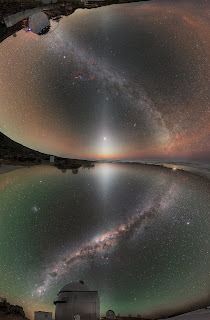To create this image, photographers Petr Horálek and Juan Carlos Casado took two photographs at observatories located on the same latitudes but in different hemispheres.
The upper half of the image was taken at the Roque de los Muchachos Observatory of the Instituto de Astrofísica de Canarias in La Palma in the Canary Islands, 29º north of the equator, while the lower half was taken at ESO's La Silla Observatory in the Chilean desert. do Atacama, 29 degrees south of the equator. When digitally combined, the two images create a continuous sweeping view of the night sky.
One of the most notable structures in the image is the whitish glowing stroke that runs vertically from the center, up and down. This is zodiacal light, a phenomenon caused by dust that permeates our Solar System by scattering sunlight, which is only visible in regions with extremely dark skies, free from light pollution.
We can still see the planet Venus shining brightly in the zodiacal light ray of the Northern Hemisphere. In the bottom image we can see several La Silla telescopes, with ESO's 1-meter Schmidt telescope in the foreground. The reflecting mirror that appears upside down in the top image is part of the Cherenkov Telescope Array (CTA), a group of gamma-ray telescopes that observe some of the most energetic phenomena in the Universe. A second group of these telescopes will be installed in the Southern Hemisphere, close to ESO's Paranal Observatory, through an agreement between the CTA Observatory and ESO.


Post a Comment